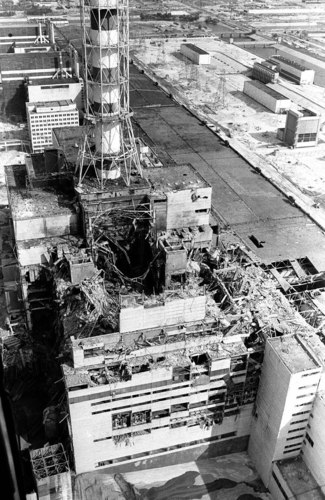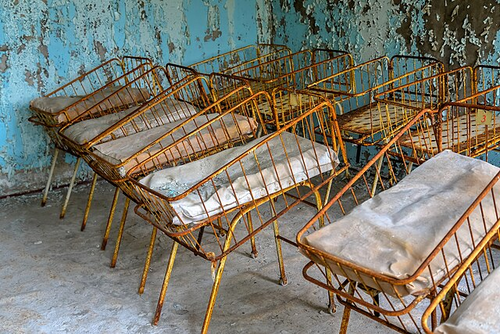Noiser
What Happened at Chernobyl?
Play Short History Of... Chernobyl
In 1986, an explosion at the Chernobyl Nuclear Power Plant in Ukraine resulted in a catastrophic disaster, with radioactive particles found as far away as Sweden. How did a routine test of reactor number 4 go so spectacularly wrong?

The Beginnings of Nuclear Power in Ukraine
Officially named the Vladimir Lenin Nuclear Power Plant after the founder of the USSR, the Chernobyl plant opened on September 26th, 1977. Due to unrealistic construction deadlines, essential safety measures were compromised. In 1982, just five years after opening, the plant suffered its first malfunction: a faulty cooling valve caused a partial meltdown in reactor number 1. While no one was killed, a dangerous amount of radiation was released into the atmosphere – an incident the Soviets were keen to keep under wraps. It took eight months to restart the reactor.
In 1985, the plant exceeded its production quota by nearly 10%, an impressive feat achieved partly by neglecting essential repairs. With planned maintenance of reactor four on the horizon, it was decided that essential small fixes could wait until then. This was a risky strategy – one that would prove to be catastrophic just six months later.
Disaster Strikes
At 1:23 am on April 26th, 1986, a routine test began on reactor number 4. The test aimed to simulate a power outage and assess the reactor's cooling capabilities. However, within 36 seconds, the situation spiralled out of control. Shift supervisor Aleksandr Akimov ordered an emergency shutdown, but it was too late.

Inside the reactor, thousands of litres of water rapidly turned to steam, with no outlet for release. The resulting pressure caused two explosions. The first destroyed the fuel channels, and the second, far more powerful, blew off the reactor's heavy steel and concrete lid. This catastrophic event released vast amounts of radioactive fuel and core materials into the atmosphere.
As Serhii Plokhy, author of "Chernobyl: History of a Tragedy", describes it, the explosion "littered the nuclear complex" with debris and unleashed a devastating wave of radiation.
Emergency Response
Firefighters arrived within five minutes, but the fire was far worse than anticipated. As emergency services struggled to contain it, many began experiencing alarming symptoms, like a metallic taste in their mouths and vomiting. Backup from Kyiv arrived, and the first responders were reluctantly taken to the hospital in Pripyat, with many succumbing to radiation poisoning.
 The evacuation of Pripyat, a town of 45,000 people near the plant, was initially delayed due to faulty radiation readings and a reluctance to cause panic. However, three more explosions at 9 PM on April 26th forced a reassessment. Thirty-six hours after the initial blast, the evacuation began.
The evacuation of Pripyat, a town of 45,000 people near the plant, was initially delayed due to faulty radiation readings and a reluctance to cause panic. However, three more explosions at 9 PM on April 26th forced a reassessment. Thirty-six hours after the initial blast, the evacuation began.

Taming the Reactor and Its Aftermath
Officials desperately tried various methods to control the reactor. Helicopters dropped sandbags into the chimney, but this only intensified the heat. A concrete base was constructed under the reactor to prevent contaminated water from seeping into rivers. By late May, radiation levels remained dangerously high. A structure known as a sarcophagus was designed to be built around the reactor to help contain the radiation. It wasn’t until November 1986 – six months after the initial explosion – that the sarcophagus was completed. Incredibly, the plant continued to function.
In February 1989, almost three years after the accident, Mikhail Gorbachev (the leader of the Soviet Union) visited Chernobyl for the first time. During his tour, he was given a list of bad news. He learnt of another near miss in a different reactor. The machinery used was not sophisticated enough to deal with contamination levels. The bulldozers tasked with clearing the polluted soil were mixing it with the clean soil, contaminating it further. And, to top it off, the sarcophagus built around the destroyed reactor four was sinking into the marshy ground. Remarkably, it would take another eleven years for Chernobyl to cease operations entirely. In the year 2000, it was finally decommissioned.
Over the following decade, the sarcophagus deteriorated further. In 2010, construction began on the New Safe Confinement, a colossal arch designed to last a century. Completed in 2018 at a cost of nearly 3 billion euros, it now encases the damaged reactor.

Despite these efforts, it is estimated that the area around Chernobyl will be uninhabitable for another 20,000 years. While thirty deaths are directly attributed to the disaster, thousands more are expected to die from long-term radiation exposure.
The Chernobyl disaster serves as a stark reminder of the potential dangers of nuclear power when safety protocols are compromised. Its legacy continues to shape nuclear energy policies and safety standards worldwide, underscoring the critical importance of rigorous oversight and caution in the pursuit of technological progress.
